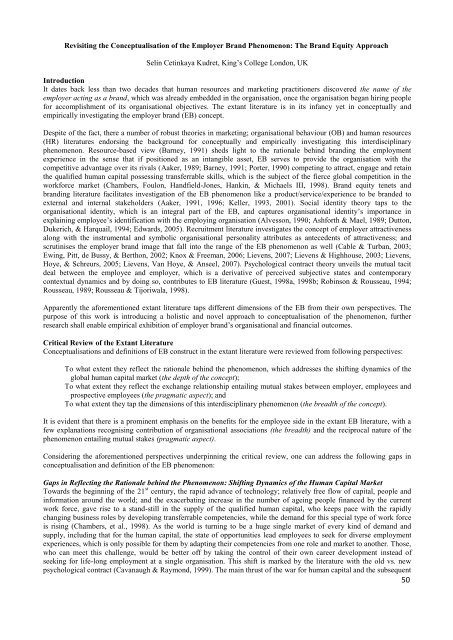Brand, Identity and Reputation: Exploring, Creating New Realities ...
Brand, Identity and Reputation: Exploring, Creating New Realities ...
Brand, Identity and Reputation: Exploring, Creating New Realities ...
Create successful ePaper yourself
Turn your PDF publications into a flip-book with our unique Google optimized e-Paper software.
Revisiting the Conceptualisation of the Employer <strong>Br<strong>and</strong></strong> Phenomenon: The <strong>Br<strong>and</strong></strong> Equity Approach<br />
Selin Cetinkaya Kudret, King‘s College London, UK<br />
Introduction<br />
It dates back less than two decades that human resources <strong>and</strong> marketing practitioners discovered the name of the<br />
employer acting as a br<strong>and</strong>, which was already embedded in the organisation, once the organisation began hiring people<br />
for accomplishment of its organisational objectives. The extant literature is in its infancy yet in conceptually <strong>and</strong><br />
empirically investigating the employer br<strong>and</strong> (EB) concept.<br />
Despite of the fact, there a number of robust theories in marketing; organisational behaviour (OB) <strong>and</strong> human resources<br />
(HR) literatures endorsing the background for conceptually <strong>and</strong> empirically investigating this interdisciplinary<br />
phenomenon. Resource-based view (Barney, 1991) sheds light to the rationale behind br<strong>and</strong>ing the employment<br />
experience in the sense that if positioned as an intangible asset, EB serves to provide the organisation with the<br />
competitive advantage over its rivals (Aaker, 1989; Barney, 1991; Porter, 1990) competing to attract, engage <strong>and</strong> retain<br />
the qualified human capital possessing transferrable skills, which is the subject of the fierce global competition in the<br />
workforce market (Chambers, Foulon, H<strong>and</strong>field-Jones, Hankin, & Michaels III, 1998). <strong>Br<strong>and</strong></strong> equity tenets <strong>and</strong><br />
br<strong>and</strong>ing literature facilitates investigation of the EB phenomenon like a product/service/experience to be br<strong>and</strong>ed to<br />
external <strong>and</strong> internal stakeholders (Aaker, 1991, 1996; Keller, 1993, 2001). Social identity theory taps to the<br />
organisational identity, which is an integral part of the EB, <strong>and</strong> captures organisational identity‘s importance in<br />
explaining employee‘s identification with the employing organisation (Alvesson, 1990; Ashforth & Mael, 1989; Dutton,<br />
Dukerich, & Harquail, 1994; Edwards, 2005). Recruitment literature investigates the concept of employer attractiveness<br />
along with the instrumental <strong>and</strong> symbolic organisational personality attributes as antecedents of attractiveness; <strong>and</strong><br />
scrutinises the employer br<strong>and</strong> image that fall into the range of the EB phenomenon as well (Cable & Turban, 2003;<br />
Ewing, Pitt, de Bussy, & Berthon, 2002; Knox & Freeman, 2006; Lievens, 2007; Lievens & Highhouse, 2003; Lievens,<br />
Hoye, & Schreurs, 2005; Lievens, Van Hoye, & Anseel, 2007). Psychological contract theory unveils the mutual tacit<br />
deal between the employee <strong>and</strong> employer, which is a derivative of perceived subjective states <strong>and</strong> contemporary<br />
contextual dynamics <strong>and</strong> by doing so, contributes to EB literature (Guest, 1998a, 1998b; Robinson & Rousseau, 1994;<br />
Rousseau, 1989; Rousseau & Tijoriwala, 1998).<br />
Apparently the aforementioned extant literature taps different dimensions of the EB from their own perspectives. The<br />
purpose of this work is introducing a holistic <strong>and</strong> novel approach to conceptualisation of the phenomenon, further<br />
research shall enable empirical exhibition of employer br<strong>and</strong>‘s organisational <strong>and</strong> financial outcomes.<br />
Critical Review of the Extant Literature<br />
Conceptualisations <strong>and</strong> definitions of EB construct in the extant literature were reviewed from following perspectives:<br />
To what extent they reflect the rationale behind the phenomenon, which addresses the shifting dynamics of the<br />
global human capital market (the depth of the concept);<br />
To what extent they reflect the exchange relationship entailing mutual stakes between employer, employees <strong>and</strong><br />
prospective employees (the pragmatic aspect); <strong>and</strong><br />
To what extent they tap the dimensions of this interdisciplinary phenomenon (the breadth of the concept).<br />
It is evident that there is a prominent emphasis on the benefits for the employee side in the extant EB literature, with a<br />
few explanations recognising contribution of organisational associations (the breadth) <strong>and</strong> the reciprocal nature of the<br />
phenomenon entailing mutual stakes (pragmatic aspect).<br />
Considering the aforementioned perspectives underpinning the critical review, one can address the following gaps in<br />
conceptualisation <strong>and</strong> definition of the EB phenomenon:<br />
Gaps in Reflecting the Rationale behind the Phenomenon: Shifting Dynamics of the Human Capital Market<br />
Towards the beginning of the 21<br />
50<br />
st century, the rapid advance of technology; relatively free flow of capital, people <strong>and</strong><br />
information around the world; <strong>and</strong> the exacerbating increase in the number of ageing people financed by the current<br />
work force, gave rise to a st<strong>and</strong>-still in the supply of the qualified human capital, who keeps pace with the rapidly<br />
changing business roles by developing transferrable competencies, while the dem<strong>and</strong> for this special type of work force<br />
is rising (Chambers, et al., 1998). As the world is turning to be a huge single market of every kind of dem<strong>and</strong> <strong>and</strong><br />
supply, including that for the human capital, the state of opportunities lead employees to seek for diverse employment<br />
experiences, which is only possible for them by adapting their competencies from one role <strong>and</strong> market to another. Those,<br />
who can meet this challenge, would be better off by taking the control of their own career development instead of<br />
seeking for life-long employment at a single organisation. This shift is marked by the literature with the old vs. new<br />
psychological contract (Cavanaugh & Raymond, 1999). The main thrust of the war for human capital <strong>and</strong> the subsequent
















